
2015 Participants at the Purdue Veterinary Medicine Open House
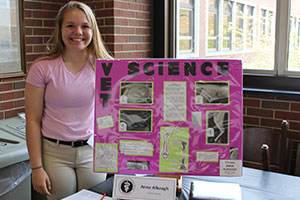
ANNA ALBAUGH
Radiology
Radiology is a well-known technique in veterinary medicine. Radiology can show many things such as, broken bones and ornaments consumed by an animal. There are many types of radiology such as: CT scans, MRI scans, x-rays, and radiation treatments.
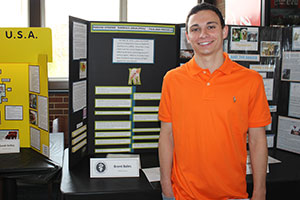
BRENT BALES
Porcine Epidemic Diarrhea Virus (PEDV)
PEDV is a serious virus because of its short incubation time and the disastrous effects it can have on a herd. During my research, I gained a new appreciation for biosecurity measures and just how important they can be.
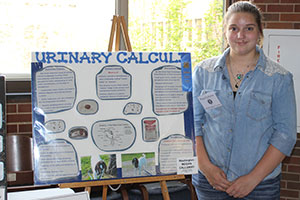
MEGAN CALLOWAY
Urinary Calculi
My project is about urinary calculi in goats. It discusses what urinary calculi is, possible symptoms, ways to prevent it and treatment options. It is a topic goat owners should be aware of and know about.

CHRISTA CHEATHAM
Let’s Lasso Diseases
My project explains about the most common beef diseases. A question about each disease can then be answered.
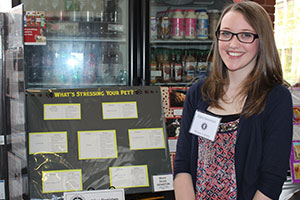
EILEE DENISTON
What’s Stressing You Pet?
My project is a poster about daily events that stress an animal. It also gives ways to reduce stress for your pet.

MCKENZIE ELLEGOOD
When Good Feeds Go Bad
How you store your feed matters. There are several types of feed and is stored in different types of containers, some are air tight while others are not.
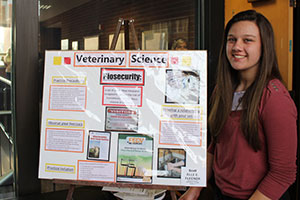
ELLE FLEENOR
Veterinary Science: Biosecurity
I defined biosecurity as a set of preventive measures designed to reduce the risk of transmission of infectious disease in livestock. I discussed practicing precautions, observing your livestock, practicing isolation, and developing a relationship with your veterinarian.

EMILY FRY
Porcine Epidemic Diarrhea Virus (PEDV)
My project covers the prevention, biosecurity and general information about the PED virus in swine.
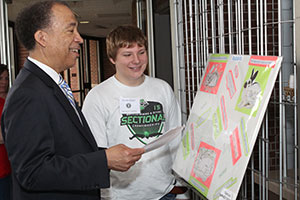
BRADY GOGEL
The Rabbit Challenge
My project is a teaching aid specifically made to help others learn about the digestive and skeletal systems of a rabbit and their body parts. The teaching aid consists of fun facts and a guessing game.
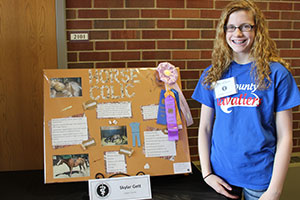
SKYLAR GOTT
Horse Colic
I chose to do my project on colic in horses. I made a poster explaining the types of colic, signs, prevention and how to treat it.

LEAH HENSLEY
Spay and Neuter
My poster covers the processes of spaying and neutering. I have also listed the reasons, along with the benefits, for spaying and neutering your pet.
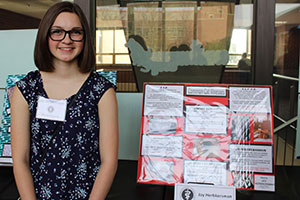
JOY HERBKERSMAN
Common Cat Illnesses
My project is about cat diseases. I wanted to learn about the different illnesses they could get.
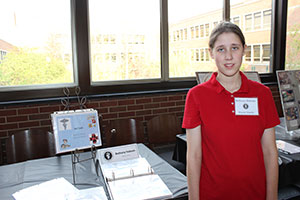
BETHANY HOBSON
Vet Tools
I created a teaching aid of 21 tools used by vets. The teaching aid could be used as either a flip chart or PowerPoint. Each tool includes the name, what it is, how it is used, and what it looks like. Questions and a special activity (matching cards) were also developed as a follow up.
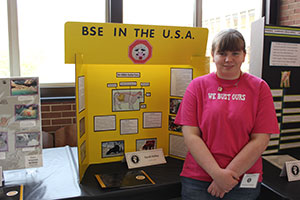
SARAH KELLEY
BSE in the USA
My project gives insight on the symptoms, effects, and treatments of BSE. It also lets you know where this disease is found in our world and what parts of the animal it effects.
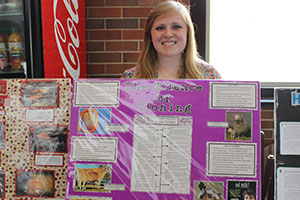
ELIZABETH KRUEGER
The Science of Cloning
My poster is about the basic knowledge of animal cloning. The poster contains information about what cloning is, the history, extra facts, and the pros and cons of animal cloning.
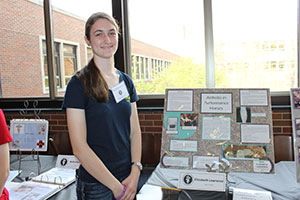
ELIZABETH LAWRENCE
Arthritis in Performance Horses
This poster and booklet give an overview on arthritis in horses. It also tells about causes, symptoms, diagnosis, management, and prevention of arthritis.
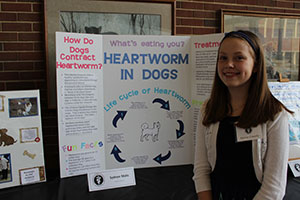
SYDNEE MALIC
What’s eating you? Heartworm in Dogs
My project is a description of heartworm in dogs. It describes the life cycle of the heartworm. It also talks about treatment and prevention.

EMMA MANN
Holey-Cow!
My project poster is on the rumen. It shows and breaks down the digestive process in a cow. I found this interesting after getting to experience, see and touch one at Purdue Boiler Vet Camp.
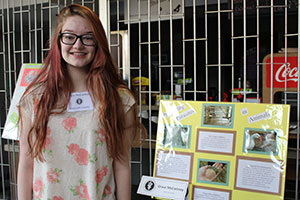
GRACE MCCARTNEY
Preventing Parasites in Animals
The best way to control parasites is to prevent them. A few key management practices for preventing parasites are presented.
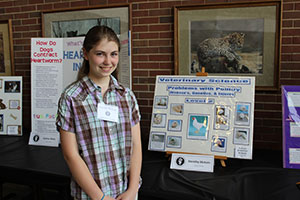
DOROTHY MCKAIN
Problems with Poultry: Diseases, Genetics & Injuries
My project explains common problems, diseases and injuries in poultry. Such as mycoplasma, vitamin E deficiency and perosis.
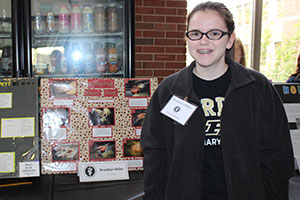
BROOKLYN MILLER
Spaying Your Dog
I have shown the basic steps of how to spay a dog. I job shadowed for this project and learned as I watched the vet spay a dog.
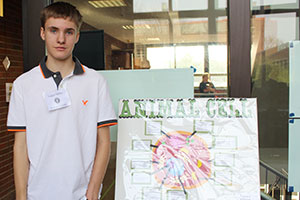
LOGAN MILLER
Animal Cell
My veterinary science poster project is a diagram that illustrates the structure and function of an animal cell. Each organelle consists of their own shape, size and function. My poster explains how an animal cell works, the organelles specific structure and the function that are vital for the survival of living organisms.
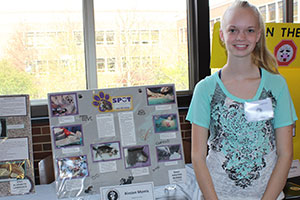
KIRSTEN MORRIS
SPOT: Stop Pet Overpopulation Today
My poster is about veterinarian specialized care. The SPOT clinic provides spaying and neutering at subsidized fees. They cater to feral cats to prevent overpopulation.
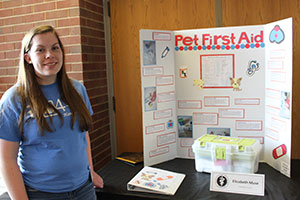
ELIZABETH MUSE
Pet First Aid
An informative display showing items that should be included in a first aid kit. The display also includes an actual first aid kit as well as a notebook with information on how to administer first aid to pets.
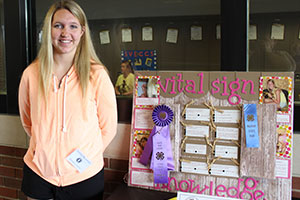
PEYTON NEWMAN
Vital Sign Knowledge
My poster "Quiz Board" demonstrates how to take vital signs on Boer Goats and the importance of knowing the signs of a healthy animal.

BETSY ROBERTS
PEDV
This is a colorful poster board about the PEDV. The board includes what PEDV is, where it came from, how to prevent it, signs of it, treatment, and how to control the spread of it.
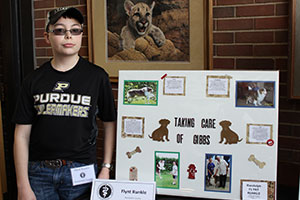
FLYNT RUNKLE
Taking Care of Gibbs
The health of a dog depends on proper grooming, medical care, and exercise. Dogs of medium to large size are very energetic, so it is necessary for them to get lots of exercise. Grooming and vet visits are ways to protect your dog.
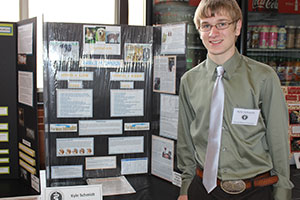
KYLE SCHMIDT
Thyroidism: The Normal, the Hypo, and the Hyper
Hyperthyroidism and hypothyroidism are the most common endocrine disorders in cats and dogs, respectively. Owners may not be aware that their pet has a thyroid disorder until a secondary issue arises, like hair loss, skin irritation, weight gain/loss, or change in personality. My desire is to provide owners with a learning aid in order to start the conversation with their veterinarian if there are concerns.
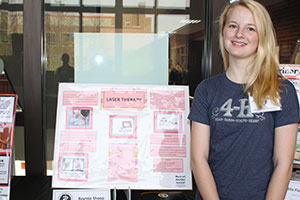
RAYMIE SHOOP
Laser Therapy
Laser therapy is a very beneficial treatment used on various types of animals and injuries. It’s fast, easy, pain free, scar free, and no anesthesia is needed. It works by stimulating blood flow and bringing red and white blood cells to the surface, helping the injury to heal and greatly reducing recovery time.
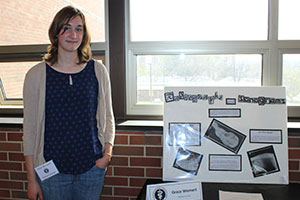
GRACE WERNERT
Radiographs and Sonograms
My project explains what x-rays are, how the work, and how veterinarians use them. It also tells how ultrasound works and why it is not harmful. The poster includes two x-rays and a sonogram.

CAMILLE WOODS
Defense Department
An animal’s immune system helps protect it against disease. Active immunity is when an animal has its own response to a pathogen by producing antibodies against that pathogen. My project explains the different types of cells and how they help maintain a healthy immune system and protect against pathogens.

